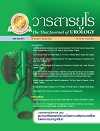Opinions of Thai Urologists in Screening and Treatment of Localized and Locally Advanced Prostate Cancer
Abstract
Background: Despite the growing large number of men diagnosed with prostate cancer in Thailand, there is no concensus in issue of screening and appropiate treatment.Objective: To evaluate the attitudes of Thai urologists in screening and treatment of prostate cancer, providing them with various specific scenarios.
Material and Method: 351 questioniares were sent to all living Thai urologists .We identified the opinions in screening of prostate cancer and the most appropriate treatment option in each scenario, assuming that they are treating themselves. Theses data were subsequently analyzed to identify factors associated with the decisions.
Result: With the response rate of 48.4%, almost half (48.2%) used PSA and DRE , one third (34.7%) used PSA only as the screening tools for prostate cancer. According to localized prostate cancer scenerio, Most urologists chose radical prostatectomy in young healthy patients, but preferred androgen deprivation therapy in elderly unhealthy patients. While in locally advanced scenario, Combination therapy was the preferred treatment for young healthy patients, and androgen deprivation seemed appropriated for elderly unhealthy ones.
Conclusion: PSA is commonly used by Thai urologists as prostate cancer screening. There are large variations of treatment selection in prostate cancer. No clear correlations can be demonstrated between surgeonûs diversity and the decision-making.
Downloads
Published
2012-06-01
How to Cite
Amnattrakul, P., Usawachintachit, M., & Santingamkul, A. (2012). Opinions of Thai Urologists in Screening and Treatment of Localized and Locally Advanced Prostate Cancer. Insight Urology, 33(1), 24–33. retrieved from https://he02.tci-thaijo.org/index.php/TJU/article/view/63163
Issue
Section
Original article



